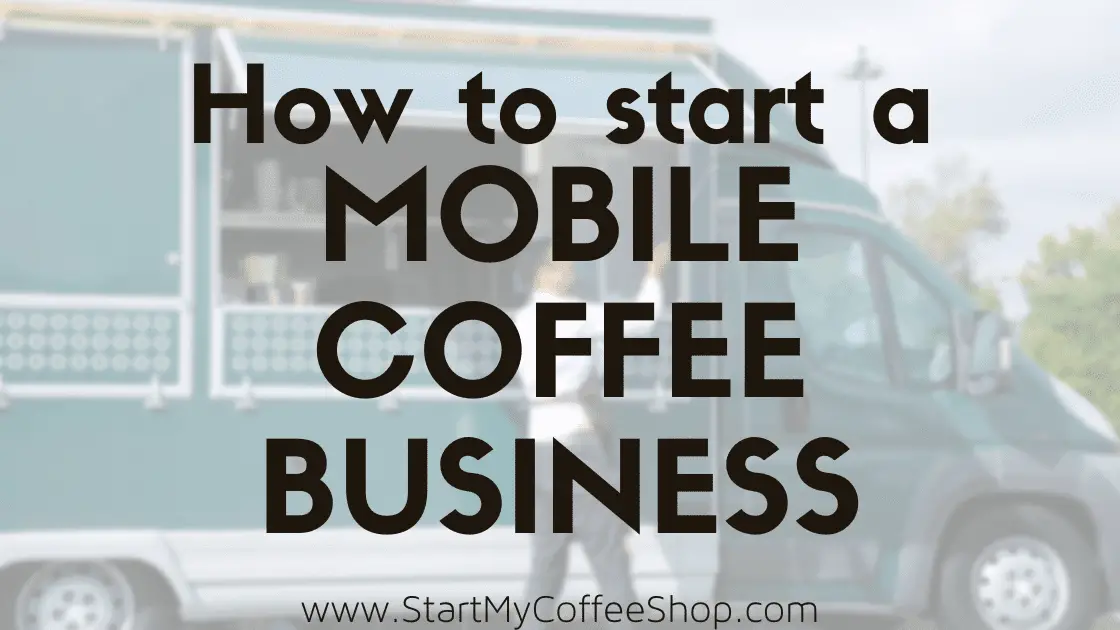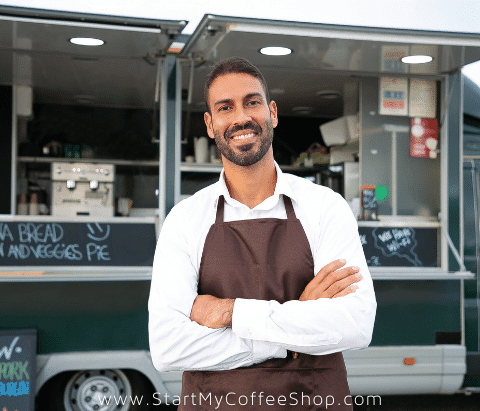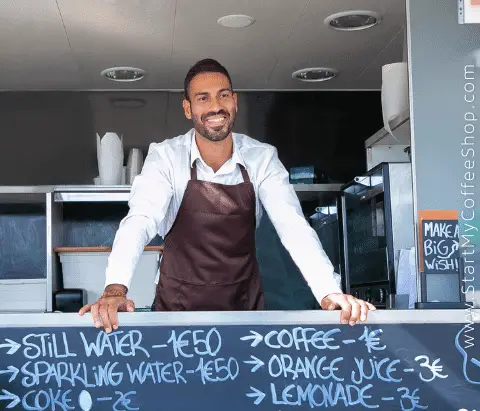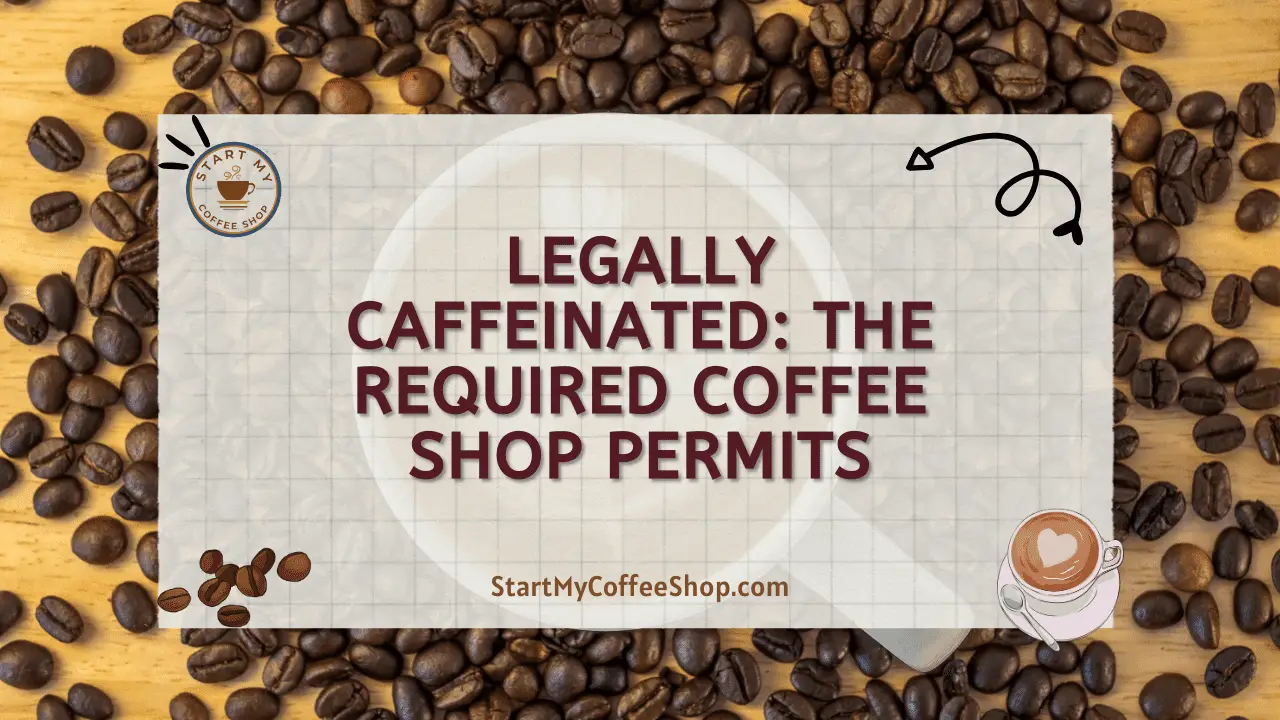So, you’re ready to go mobile with that coffee business plan of yours — or at least you’re considering the possibility of doing so. Well, hitting the road with all that coffee is a great idea! Good thinking! Caffeine on wheels isn’t merely the dream for consumers — it’s also a fun, interesting way for you to diversify your clientele without the locational limitations that generally come with running a more stationary business.
To start a mobile coffee business:
- Determine your name and brand so that you know what you’re doing, what you’re offering, and who you’re trying to serve before doing anything else,
- Find the right truck for your specific space, size, mobility, product, and service needs,
- Set up the truck accordingly with all the necessary utilities, gear, and appliances, plus any additional features you may need to run your business smoothly,
- Decide on accepted payment methods so that you can set up your card reader, cash box, Paypal, and/or Venmo accordingly,
- Create a portable menu so that customers don’t have to struggle to access your offerings, and finally,
- Figure out a schedule and reach out to venues in your area so that you can keep your business frequent, stable, and thriving.
Determine your name and brand
Before you can do anything else, the first thing you must do is envision what you want your mobile coffee business to be. You’ll want to figure out the name of your business, the general aesthetic, the items you want to serve, and who you want your customers to be. If you don’t know these things before continuing on to the next steps, you run the risk of wasting time, space, effort, and worst of all, money.
Turning customers off is another possible [and likely] consequence of launching your new coffee venture unprepared. People like businesses that are sincere, genuine, and have that privately-owned flare, but still feel like they know what they’re doing. It’s a delicate balance that can be difficult to strike at first. Still, rest assured it’ll come to you with time.
While patience isn’t everyone’s strong suit, it pays off to wait until you know the direction you’re taking your business, and what it’s all about. Rushing to get things off the ground before you even fully understand your business will, by contrast, almost certainly result in disaster. That’s why it’s better to do the grunt work now — so that you don’t have to later when your business might actually be on the line.
Plus, once you’ve covered all these bases, you finally get to dive into the really fun stuff!
Find the right truck
As you already know, you’ll need a vehicle in order to be mobile! The most popular option for those running mobile food and drink businesses tends to be a truck.
Now, trucks come in a variety of shapes and sizes. Whatever you end up getting, keep in mind that gas fees do factor in — so, if you were eyeballing a gas guzzler that extends beyond the amount of space you need, it might be a good idea to reconsider and go with something smaller.
Since coffee businesses are, for the most part, not as space-occupying as other types of businesses in the service industry (such as a restaurant that serves a complete breakfast, lunch, and dinner throughout the day), looking into a more medium-sized truck might be optimal. Of course, you don’t want to skimp so much that you don’t have enough space. That would not only be miserable for you but also likely to hinder the quality of what you’re serving. Moreover, don’t forget about the harm a cramped space might do to your business’s overall efficiency!
If you offer baked goods, you’ll probably already have those made by the time you set off in your truck for the day. For those, you may need something in which to reheat them and any potential condiments, but overall, they shouldn’t be too space-consuming. Similarly, all your beverage equipment should be comfortable on a long counter or two within the truck itself. Finally, if yours is the type of coffee shop that offers fresh, quick food, a grill might be something worth including!
Don’t forget to factor in the space human bodies will take up inside the truck, either. While a one-person operation is possible, chances are you’ve arranged for some assistance. Therefore, you’ll need to ensure you’re able to fit everyone in your truck with enough room for people to move and prepare food without creating any increased risk for potential hazards.
Set up the truck
As we mentioned in the previous section, your truck will have lots of stuff in it by the time you’re all done setting it up. In fact, you’ll need to figure out electricity, plumbing, lighting, appliances, wallpaper, flooring, seating, surfaces, refrigeration, storage, cleaning products, dishes, and more. While all of this may seem overwhelming, fear not — you can hire professionals to help you out.
Remember that your customers won’t see any part of the inside of your truck that isn’t already visible through the windows. However, if you’re truly concerned about privacy, you can always look into curtains. Window coverings are a good way to draw attention away from your truck late at night, too — after you’re all done serving for the day.
Decide on accepted payment methods
Figuring out payment methods can be a pain at first, but you’ll be relieved when it’s all over. Likewise, you’ll be glad you went through the trouble before getting things rolling.
For starters, you’ll want to figure out what type(s) of payment you’re willing to accept from customers. Some of the most popular options are credit and debit cards, cash, Paypal, and Venmo. The latter two both function as wiring services, and are supported by all the major banks. In other words, they’re safe enough to function as payment methods for your mobile coffee business!
In figuring out your payment methods, be sure to consider who your clientele might be. Middle-aged business professionals? They’ll probably want to pay with a card. Teenagers and young adults? They might tend towards cash, Paypal, or Venmo.
And, of course, the venue or event your truck is at will also determine how people might prefer to pay. For example, if you’re at some sort of a festival or convention, people are more likely to pay in cash, or else through one of the wiring services. However, if you frequent an apartment complex, residents might find it more convenient to just use their cards.
If you’re taking credit and debit cards, you’ll want a card reader. While most credit and debit cards these days have chips, they also generally have the swipe feature — meaning a simpler, old-school card reader can still be a viable option (even if it doesn’t do card chips).
Some card readers are stand-alone, meaning they don’t attach to another device. Conversely, some card readers require a laptop, cell phone, or tablet. These must be attached to the device of your choosing in order to work and may involve you having to download an app and/or make an account of some sort. Regardless of what you choose, we strongly advise keeping a backup card reader around just in case something goes wrong. Technology is fickle, but many card readers are surprisingly affordable!
If you’re accepting cash, a cash box with a lock and key is recommended. For Paypal and Venmo, you’ll want to set up your accounts and keep a large sign set up on the outside of the truck with all the information people need to wire you their money.
This is also a good time to mention that you’ll want to determine a system for receipts so you’ll have them for your records, and your customers will have them for theirs. No matter what you end up deciding to do regarding payment, don’t forget to keep your books up to date!
Create a portable menu
Failing to make your menu as widespread and accessible as possible may prove to inconvenience you in addition to your customers.
That’s why easily accessible, large, legible menus are extremely important when operating a mobile food and/or beverage business. People want the convenience of being able to glance at the side of the truck, check out your social media, visit your website, or grab a disposable pamphlet and have the entire menu available to them.
The more mobile menu options also allow for people to better share your information with their friends, or else track where you’ll be so they can come to get more coffee from their favorite coffee truck! Some mobile restaurants even take virtual orders so that people can just come to pick up their food as soon as it’s ready.

Figure out a schedule and reach out to venues in your area
While technically you can just drive your mobile coffee business around wherever and whenever you like, this isn’t generally the best way to go about having a mobile business of this nature. Rather, it’s vital to know your hours beforehand.
Why? Because you’ll need prep time in the morning, likely before even getting into the truck, and then time to drive to your location. You’ll also need to consider when to schedule yourself and/or your staff. Improvising these things will cause more harm than good for your business.
If you’re in a location where food trucks are an especially significant part of food, art, and/or social culture, be sure to socialize and network with fellow mobile business owners so that you’ll always be in the loop. Even if you aren’t in a food truck hotspot, it’s still worth getting friendly with other owners.
Reach out to possible venues in your area. Many mobile food and drink businesses schedule times with apartment complexes and hotels. This way, residents and guests can buy their food and drinks easily, gobble that lovely stuff up, and revel in the sheer convenience of it all.
Additionally, fairs, conventions, conferences, and parties often benefit from the presence of food trucks. Another terrific place to set up is outside art galleries, bookstores, and other shared cultural, intellectual, creative spaces where people always have that hankering for a nice, hot cup of something delicious.
Frequently Asked Questions
The pros of starting a mobile coffee business include mobility, as well as additional opportunities for geographical exploration, diversifying your customer base, and getting your name out there to further boost sales in the future. The sky is the limit.
While there are many pros to starting a mobile coffee business, some of the cons include the inconsistency of location, lack of regular, reliable, loyal customers, less space, higher gas bills, and potential limits regarding the items you can serve. The varying schedule can also prove to be a drawback for some people.
To learn more on how to start your own coffee shop checkout my startup documents here
Please note: This blog post is for educational purposes only and does not constitute legal advice. Please consult a legal expert to address your specific needs.

Hi! I’m Shawn Chun
My adventure in coffee began when I first launched my first coffee shop back in the early 2000s. I had to figure out so many things on my own and to make it worse within 2 years of opening two large corporate coffee chains moved in just blocks away from me!
As I saw smaller and even some larger coffee shops in the neighborhood slowly lose customers to these giant coffee chains and slowly close up shop, I knew that I had to start getting creative…or go out of business.
I (like you may be) knew the coffee industry well. I could make the best latte art around and the foam on my caps was the fluffiest you have ever seen. I even had the best state-of-the-art 2 group digital Nuova Simonelli machine money could buy. But I knew that these things alone would not be enough to lure customers away from the name brand established coffee shops.
Eventually, through lots of trial and error as well as perseverance and creativity I did find a way to not only survive but also thrive in the coffee/espresso industry even while those corporate coffee chains stayed put. During those years I learned to adapt and always faced new challenges. It was not always easy, however, in the end, I was the sole survivor independent coffee shop within a 10-mile radius of my location. Just two corporate coffee chains and I were left after that year. All told the corporate coffee chains took down over 15 small independent coffee shops and kiosks and I was the last one standing and thriving.
Along the years I meet others with the same passion for coffee and I quickly learned that it is not only “how good a barista is” that makes a coffee shop successful, but the business side of coffee as well.
Hence why I started this website you are on now. To provide the tools and resources for up and coming coffee shop owners to gain that vital insight and knowledge on how to start a coffee shop successfully.
Stick around, browse through my helpful blog and resources and enjoy your stay! With lots of LATTE LOVE!
Shawn








